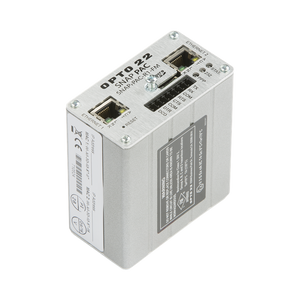OPTO 22 - SNAP-PAC-EB1-FM _ SNAP PAC Ethernet Brain, analog/digital/serial, with high-speed digital functions, Factory Mutual approved
- Brand
- OPTO 22
- SKU:
- SNAP-PAC-EB1-FM
OPTO 22 - SNAP-PAC-EB1-FM _ SNAP PAC Ethernet Brain, analog/digital/serial, with high-speed digital functions, Factory Mutual approved
OPTO 22 - SNAP-PAC-EB1-FM _ SNAP PAC Ethernet Brain, analog/digital/serial, with high-speed digital functions, Factory Mutual approvedSpecifications:
- SNAP PAC Ethernet Brain
- analog/digital/serial
- with high-speed digital functions
- Factory Mutual approved
NOTE: Due to the unavailability of essential parts, SNAP PAC EB-series brains have reached their end of life as of March 1, 2022. Instead, use a SNAP-PAC-R1 controller/brain; it has all the same features plus additional power (and programmability, if you need it).
The SNAP-PAC-EB1-FM brain is an I/O and communications processor for your control system. Designed primarily to work in distributed systems controlled by a SNAP PAC S-series or R-series controller, the SNAP-PAC-EB1-FM can also be controlled by a groov EPIC processor or used as intelligent remote I/O with Allen-Bradley industrial PLC systems. The SNAP-PAC-EB1-FM provides local intelligence that frees the controller (PAC, EPIC, or PLC) for supervisory tasks.
NOTE: The SNAP-PAC-EB1-FM offers the same functions as the SNAP-PAC-EB1 brain but is Factory Mutual approved (U.S. and Canada). If you do not need FM approval, see the SNAP-PAC-EB1.
As an I/O processor, the SNAP PAC brain independently handles functions such as latching, counting, thermocouple linearization, watchdog timers, and PID loop control. These functions continue to work on the brain even if communication with the controller is lost.
The SNAP-PAC-EB1-FM brain supports all the SNAP I/O analog, digital, and serial input and output modules available on the Opto 22 website. These modules can all be mixed on the same mounting rack and placed in any position on the rack. The brain and modules mount on a SNAP PAC rack, which holds up to 4, 8, 12, or 16 modules.
NOTE: In order to use Opto 22 serial modules with an EB2 brain, the I/O should be controlled by a SNAP PAC controller or groov EPIC processor running a PAC Control strategy.
In addition to I/O processing, the SNAP PAC brain communicates over a standard 10/100 Mbps Ethernet network. The brain is equipped with two switched Ethernet network interfaces. Because these interfaces share a single IP address and act just like an Ethernet switch, SNAP PAC brains can be installed in a multi-drop (daisy-chain) configuration, extending the control network without the added expense of additional Ethernet network hardware. SNAP PAC brains can also be installed in a star configuration using standard, off-the-shelf Ethernet network components.
The SNAP-PAC-EB1-FM brain supports communication using multiple protocols running simultaneously over Ethernet. Most customers use the PAC Project software suite for control, monitoring, and data acquisition. At the same time, you can communicate using other methods, including EtherNet/IP, Modbus/TCP, SNMP, SMTP, FTP, and OptoMMP. Communication with OPC 2.0-compliant clients is available through OptoOPCServer. Additional programming options are available when the EB is used with a groov EPIC processor.
The SNAP-PAC-EB1-FM brain offers high-speed digital functions, including high-speed counting (up to 20 KHz, depending on the module), quadrature counting, pulse generation and measurement, and TPO (time-proportional output). Pulse generation and measurement require PAC Control and a SNAP PAC controller or groov EPIC processor, or using the brain with Allen-Bradley PLC systems. For a complete list of features and specifications, see form #1689, the SNAP PAC Brains Data Sheet, under the Docs & Downloads tab.
If you do not need high-speed digital functions, choose the SNAP-PAC-EB2-FM brain instead.
Compare SNAP PAC controllers and brains.
If you are not using PAC Project software and a SNAP PAC controller or groov EPIC processor with this brain and instead need to communicate directly with it, see the SNAP PAC .NET OptoMMP SDK.
Build your system in the SNAP I/O Configurator.
Specifications:
| Ethernet and Serial Brains [Ethernet Brains are Obsolete 3/1/22] | |
| Power Requirements | 5.0–5.2 VDC at 750 mA maximum (does not include module power requirements) |
| Memory | 16 MB RAM |
| Backup battery for real-time clock | Rechargeable (recharges whenever the brain has power). 5-year life when power is off (replacement part number: SNAP-PAC-BATTERY-ML2430). (Models manufactured before August 2007 have a 3-volt CR2032 lithium battery, available in retail stores. See original user guide for replacement steps.) |
| Hold-down screw | Torque: 8 in-lb (0.9 N-m) |
| Operating Temperature | -20 to 60 °C |
| Storage Temperature | -40 to 85 °C |
| Humidity | 0–95% humidity, non-condensing |
| Agency certifications | -EB models: UL, CE, RoHS, DFARS; UKCA |
| Warranty | 30 months from date of manufacture |
| Ethernet Brains (EB) only | |
| Ethernet Network Interfaces | IEEE 802.3 network, 10Base-T and 100Base-TX. Supports Auto MDI-X (crossover cable not needed). Two switched interfaces, allowing multi-drop (daisy-chain) or standard star network configuration. |
| Maximum Ethernet Segment Length | 100 meters with Category 5 or superior UTP |
| Serial Brains (SB) only | |
| Network interfaces | RS-485, 2- or 4-wire, twisted pair(s), with shield |
| Serial data rates | 300 baud to 230.4 Kbaud |
| Range: Serial multidrop | 32 stations maximum on a segment (including PC, controller, repeaters, and I/O units); up to 3000 ft (914 m) on a segment |







